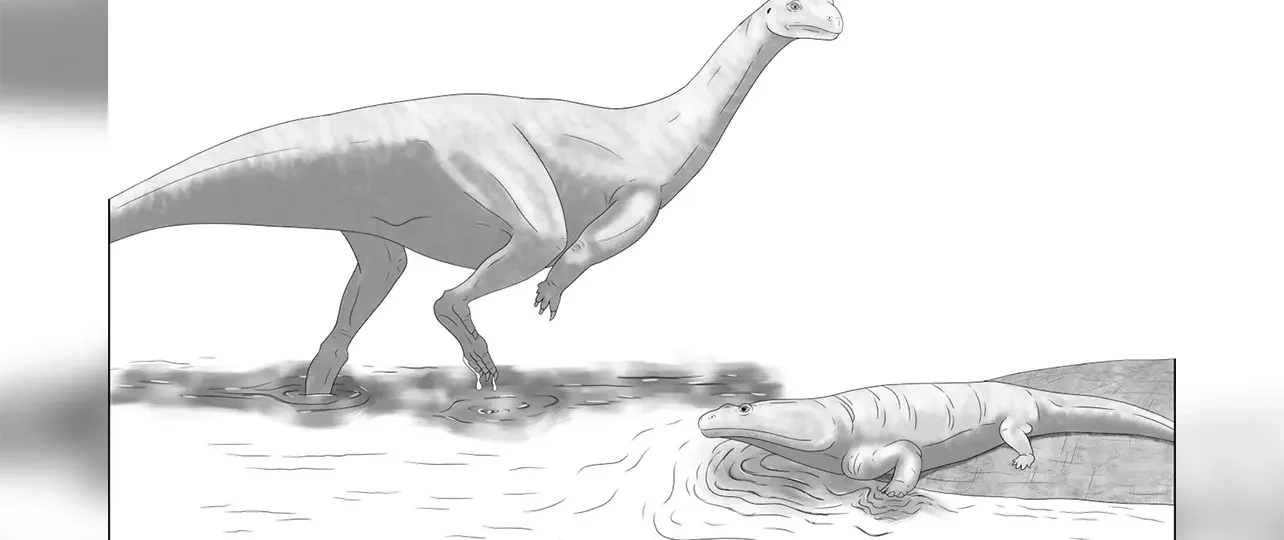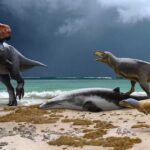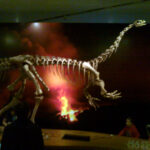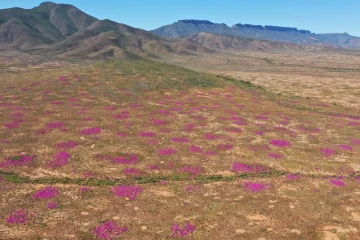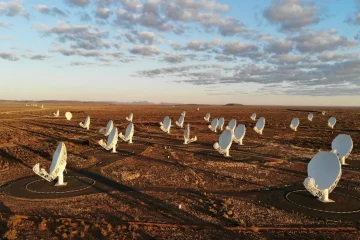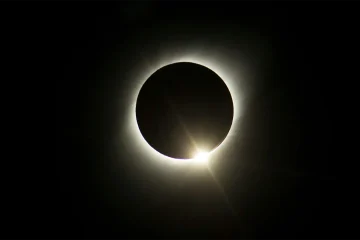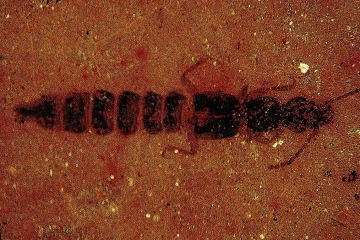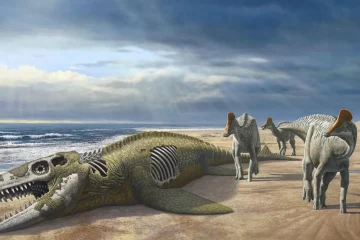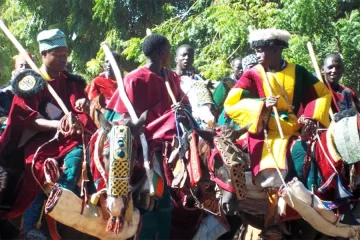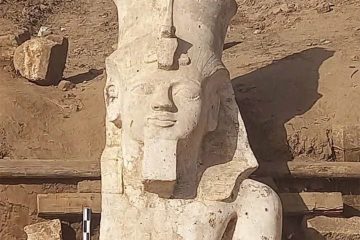VISITORS to Lake Kariba – the world’s largest man-made lake, along the border between Zambia and Zimbabwe – come to enjoy the abundant wildlife, fine fishing or spectacular scenery. However, in 2017, our crew of palaeontologists came to Zimbabwe to hunt game of a different kind: dinosaurs.
Many of our discoveries are still under study, but the team has just announced its first new dinosaur, dubbed Musankwa sanyatiensis.
At first sight, it’s unremarkable – just a few bones from a single hind leg. It was found with the thigh, shin and ankle bones still connected, but weathering out on the shore of Spurwing Island. However, once it was cleaned and back in the laboratory at the University of the Witwatersrand in South Africa, close comparisons with other Late Triassic (235-199 million years ago) dinosaurs from Africa and elsewhere revealed that it had several unique features that marked it out as a previously unknown species. Those features included the shapes and sizes of the areas where the muscles would have attached to the bones.

Musankwa is only the fourth dinosaur to be named from Zimbabwe and the first named from the mid-Zambezi Basin (north Zimbabwe, southern Zambia) for 50 years. Although the material is incomplete, its close relatives were large, bipedal herbivores (plant-eating creatures that walked on two legs) with long necks, small, lightly built skulls, pillar-like hindlimbs, and sturdy tails. Musankwa would have looked very similar overall, and calculations (based on its limb bones) show it would have weighed a hefty 390kg – about the same as a horse.
Lake Kariba expeditions
Lake Kariba sits at the heart of a vast geological feature, the Mid-Zambezi Basin, which covers north-western Zimbabwe and extends into neighbouring Zambia. This deep, bowl-like structure is filled with thousands of metres of strikingly coloured, brick-red mudstones and sandstones that were deposited by ancient river systems during the Late Triassic and Early Jurassic periods (235-176 million years ago).
In the 1970s, pioneering Zimbabwean palaeontologists Geoffrey Bond and Michael Raath discovered the remains of an enormous dinosaur on one of the islands dotting the lake. But the remoteness of the region made further work difficult, and they did not return to build on their earlier success. As a result, the area was overlooked by other dinosaur scientists, even though there was clear potential for new discoveries to be made.
A few years later, a small band of dedicated fossil sleuths led by Steve Edwards – a local safari camp manager – started making new discoveries of teeth and bones around the lake. News of these finds quickly filtered through the close-knit community of southern African palaeontologists, reaching the team at the University of the Witwatersrand, in Johannesburg. After discussions, a plan was hatched to visit the area in the hope of finding more complete material.
In 2017-18, we were part of the joint team of Zimbabwean, South African and UK scientists that mounted two expeditions to Lake Kariba, using the houseboat Musankwa as our floating laboratory.
The houseboat was essential to our trip: it allowed us to cover large distances, and transport our gear and finds. It also gave us somewhere safe to stay – camping was not permitted in Matusadona National Park due to the large populations of elephant, hippo and other game present.
It was in honour of our houseboat and the Sanyati River, which empties into the lake nearby, that we named our new dinosaur find Musankwa sanyatiensis.
Ancient discoveries
From the houseboat, we used small boats to reach shore and to navigate the sinuous inlets heading inland.
Our days on Lake Kariba involved finding promising patches of bare rock along the shore and exploring these in the hope of finding bone. Fossil bone turned out to be common and we started adding many new locations to those reported historically.
Although the lake shore is flat and the walking was easy, temperatures and humidity were always high (around 40°C), meaning even gentle strolls or attempts to dig involved working up a sweat. We also had to be on the alert for the local wildlife, which we encountered daily, so we often spent as much time looking up and around us as we did with eyes on the ground.
Starting from the spots that Steve identified we quickly found new material, including the teeth, jaw bones and armour plates of a crocodile-like aquatic predator called a phytosaur (the first example of this group to be discovered in southern Africa).
We also found lungfish teeth and dinosaur bones. The detailed geological study revealed that these fossils were deposited in an ancient freshwater swamp – a surprise as most other fossil localities in this part of the world were laid down in drier, more arid environments.
Unknown histories
Our newly discovered Musankwa sanyatiensis specimen, and others still being studied, highlight the potential of Zimbabwe for more new dinosaur discoveries. This helps to fill a major gap in our knowledge of African dinosaurs in general.
Currently, we know relatively little of dinosaur history in this part of the world – the continent’s size is both a blessing and a curse for palaeontologists. However, we hope that this work will help to mark the start of a new chapter in understanding Zimbabwe’s deep past.
Palaeontologist Tim Broderick, from the Zimbabwe Geological Survey and of Jeremy Prince and Associates, Groundwater Consultants, and Darlington Munyikwa, from the National Museums and Monuments of Zimbabwe, contributed to the research and this article.
Paul Barrett, Individual Merit Researcher, Natural History Museum;
Jonah Choiniere, Professor of Dinosaur Paleontology, University of the Witwatersrand;
Kimberley E.J. Chapelle, Assistant Professor, University of the Witwatersrand;
Lara Sciscio, Researcher and curator, Jurassica Museum,
and
Michel Zondo, Curator of Palaeontology, Natural History Museum of Zimbabwe, Palaeontology student, University of the Witwatersrand
- This article is republished from The Conversation under a Creative Commons license. Read the original article.

